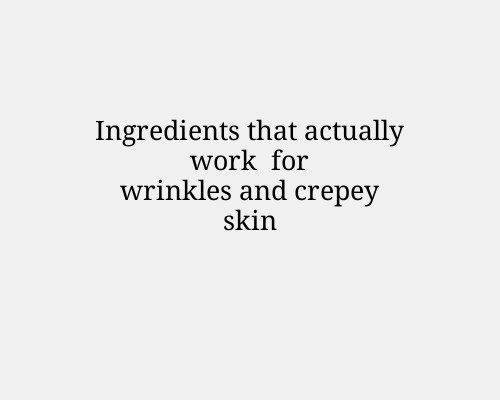
Best eye creams for wrinkles and crepey skin: Ingredients that actually work
When it comes to tackling wrinkles and crepey skin around the eyes, not all products are created equal. The skin around the eyes is thin and delicate, making it more prone to early signs of aging like fine lines, sagging, and puffiness. Choosing the right eye cream involves understanding which ingredients are backed by clinical research and how they function. This comprehensive guide breaks down the best eye cream ingredients that actually work and how to choose products that deliver visible results.
Why the eye area ages faster
The eye area has fewer oil glands, less collagen, and thinner skin compared to other parts of the face. These characteristics make it especially vulnerable to:
Dehydration
Loss of elasticity
Sun damage
Repeated facial movements
Poor sleep and circulation
The right eye cream can help replenish hydration, stimulate collagen, and improve skin texture and tone — but only if it contains proven ingredients.
Clinically proven ingredients that work
Retinol (Vitamin A derivative)
Retinol is a gold-standard anti-aging ingredient. It accelerates skin cell turnover, boosts collagen production, and reduces the appearance of fine lines.
Benefits: Improves skin texture, reduces crow’s feet, smooths crepey skin.
Caution: Start with low concentrations (0.1–0.3%) to avoid irritation. Use only at night and always follow with SPF in the morning.
Look for: Encapsulated or slow-release retinol in eye-specific formulations.
Peptides
Peptides are short chains of amino acids that signal your skin to produce more collagen and elastin.
Benefits: Firming effect, smoother texture, reduced wrinkles and under-eye bags.
Types to look for: Matrixyl (palmitoyl pentapeptide), Argireline (acetyl hexapeptide), and copper peptides.
Why they matter: Peptides support skin structure without the irritation retinol sometimes causes.
Hyaluronic Acid
Hyaluronic acid is a powerful humectant that draws moisture into the skin and plumps up fine lines.
Benefits: Hydrates dry skin, reduces the look of wrinkles, and improves skin elasticity.
Forms to consider: Sodium hyaluronate (a smaller molecule that penetrates deeper).
Tip: Look for multi-molecular weight formulas for surface and deep hydration.
Niacinamide (Vitamin B3)
Niacinamide strengthens the skin barrier, improves texture, and reduces pigmentation and inflammation.
Benefits: Brightens dull skin, evens out tone, reduces redness and dark circles.
Bonus: It pairs well with other ingredients like peptides and hyaluronic acid.
Caffeine
Caffeine is a vasoconstrictor that reduces puffiness and improves circulation.
Benefits: Reduces under-eye bags, brightens the eye area, and firms temporarily.
Best for: Morning use or before makeup application.
Vitamin C
Vitamin C (ascorbic acid or derivatives like sodium ascorbyl phosphate) is a potent antioxidant that protects and repairs aging skin.
Benefits: Brightens dark circles, boosts collagen, and reduces oxidative stress.
Stability tip: Choose stabilized or encapsulated forms to reduce irritation.
Secondary but useful ingredients
Ceramides: Help maintain the skin barrier and lock in moisture.
Squalane: A non-irritating moisturizer that mimics natural oils.
Licorice Root Extract: Reduces pigmentation and soothes skin.
Panthenol (Vitamin B5): Provides deep hydration and soothes irritation.
Bakuchiol: A gentler alternative to retinol for sensitive skin.
What to avoid in eye creams
Some ingredients can be too harsh for the delicate eye area:
Fragrance: Can cause irritation or allergic reactions.
Essential oils: Often irritating, even when labeled as "natural."
High concentrations of AHAs/BHAs: Too strong for thin under-eye skin.
Heavy oils: May clog pores or cause milia (tiny white bumps).
How to choose the right eye cream
Step 1: Identify Your Primary Concern
Wrinkles and crow’s feet: Look for retinol + peptides.
Crepey texture: Go for peptides + hyaluronic acid + niacinamide.
Dark circles: Vitamin C + caffeine + niacinamide.
Puffiness: Caffeine + peptides + cooling applicators.
Step 2: Match Formula to Skin Type
Dry skin: Creams with hyaluronic acid, ceramides, and squalane.
Oily or combo skin: Gel formulas with niacinamide and caffeine.
Sensitive skin: Fragrance-free, low-irritant products with bakuchiol or peptides.
Step 3: Consider Packaging
Airless pumps or tubes are preferred. They protect sensitive ingredients from oxidation and reduce contamination.
Avoid jars unless they come with an applicator and are stored away from direct light.
Application tips for maximum results
Use a pea-sized amount for both eyes.
Tap gently with your ring finger — never rub or pull the skin.
Apply to the orbital bone area, not directly on the eyelids (unless the product is labeled safe for lids).
Use twice daily unless it contains retinol (then limit to nighttime).
Recommended products based on ingredient profiles
RoC Retinol Correxion Eye Cream
Retinol + glycerin; affordable and well-tolerated.
Olay Regenerist Retinol 24 Night Eye Cream
Retinol + niacinamide in a fragrance-free formula.
The Inkey List Caffeine Eye Cream
Lightweight, great for puffiness and dark circles.
Paula’s Choice Resist Anti-Aging Eye Cream
Contains peptides, hyaluronic acid, and antioxidants.
Drunk Elephant C-Tango Multivitamin Eye Cream
Vitamin C, peptides, and ceramides in a rich cream.
Neutrogena Hydro Boost Eye Gel-Cream
Pure hyaluronic acid and dimethicone for hydration.
Final thoughts
An effective eye cream is about the right ingredients, not the price tag. Focus on formulas that combine clinically proven actives like retinol, peptides, hyaluronic acid, and niacinamide. Avoid products loaded with fillers, fragrance, and unnecessary irritants. With consistent use and realistic expectations, the right eye cream can significantly improve the appearance of wrinkles, crepiness, and dark circles over time.